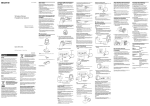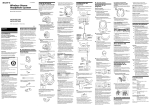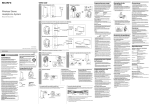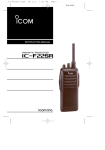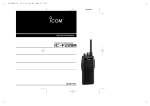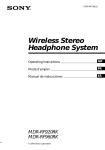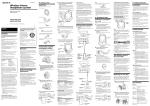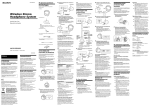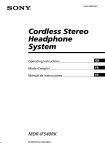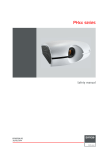Download Sony MDR-IF245RK
Transcript
How to use 1 Cordless Stereo Headphone System Effective area of the transmitter Insert the supplied rechargeable battery BP-HP550-11 into the left housing of the headphones. The illustration below shows the approximate area covered by the infrared rays emitted from the transmitter when you wear the headphones and face the transmitter. Observe the correct polarity when installing battery. Top view Approx. 3 m (10 ft) Approx. 8 m (26 ft) Transmitter Insert the end first. 4-429-158-14(1) ©2012 Sony Corporation Printed in China 2 Connect the AC adaptor. To AC outlet MDR-IF245RK 3 Side view Transmitter TMR-IF245R (1) Headphones MDR-IF245R (1) AC adaptor (1) Features Thank you for purchasing the Sony MDR-IF245RK Cordless Stereo Headphone System. Before operating the unit, please read this manual thoroughly and retain it for future reference. Some features are: – Lightweight headphones for long time listening comfort. – Approx. 28 hours playback with supplied Ni-MH rechargeable battery. AAA alkaline batteries (not supplied) can also be used as alternative power. – Battery is automatically charged by placing the headphones on the transmitter. – 40 mm driver units for powerful, expressive sound. – Muting function reduces noise disturbance. – Self-adjusting headband mechanism eliminating the need for headband adjustment. – Up to 8 meters (26 feet) reception range. Connect the A/V component, following hookup or below. Using the headphone jack of the A/V component About muting function Headphone jack (Stereo mini jack) Connecting cable (stereo mini plug pin plug × 2), 1 m (1) R (red) L (white) If the infrared rays are obstructed, or the headphones are used outside their effective range, noise will increase and sound will become hard to hear. In such a case, this function mutes any sound from the headphones to avoid potential ear damage as a result of noise. Sound is automatically restored when you move nearer the transmitter or remove the obstruction. Stereo mini plug WARNING Do not expose the batteries (battery pack or batteries installed) to excessive heat such as sunshine, fire or the like for a long time. To avoid electrical shock, do not open the cabinet. Refer servicing to qualified personnel only. Do not install the appliance in a confined space, such as a bookcase or built-in cabinet. As the main plug of AC power adaptor is used to disconnect the AC power adaptor from the mains, connect it to an easily accessible AC outlet. Should you notice an abnormality in it, disconnect it from the AC outlet immediately. Excessive sound pressure from earphones and headphones can cause hearing loss. Charge supplied battery first L (white) The supplied rechargeable nickel-metal hydride battery is not charged from the first time you use it. Be sure to charge them before use. Audio out (L/R) jacks About auto charge function Placing the headphones on the transmitter automatically turns them off, then charging starts. This eliminates the need for turning on/off every time you wear and take off the headphones. Note This equipment has been tested and found to comply with the limits for a Class B digital device, pursuant to Part 15 of the FCC Rules. These limits are designed to provide reasonable protection against harmful interference in a residential installation. This equipment generates, uses and can radiate radio frequency energy and, if not installed and used in accordance with the instructions, may cause harmful interference to radio communications. However, there is no guarantee that interference will not occur in a particular installation. If this equipment does cause harmful interference to radio or television reception, which can be determined by turning the equipment off and on, the user is encouraged to try to correct the interference by one or more of the following measures: – Reorient or relocate the receiving antenna. – Increase the separation between the equipment and receiver. – Connect the equipment into an outlet on a circuit different from that to which the receiver is connected. – Consult the dealer or an experienced radio/ TV technician for help. Stereo mini plug If CHG indicator is not lit R (red) Check if the right and left headphones are rested on the transmitter correctly. Take off the headphones and place them on the transmitter again so that the headphones’ contact points meet the transmitter’s contact pins. Stereo system, Blu-ray Disc player, DVD player, TV*, etc. * In case of no headphone jack. Charging and usage time If you want to receive audio on the headphones while at the same time hearing audio from the television speakers: connect the transmitter to your Cable Box/Satellite Box rather than your television. 5 6 Wear the headphones. Before listening To reduce the risk of hearing damage, first lower the volume. Depending on the remaining battery status, it takes approx. 30 minutes to 7 hours to recharge. Start playback of the A/V component. Up The nameplate is located on the bottom exterior. Approx. charging time Approx. usage time1) 7 hours2) 28 hours3) 1) at 1 kHz, 0.1 mW + 0.1 mW output 2) hours required to fully charge an empty battery 3) Time may vary, depending on the temperature or conditions of use. Tactile dot AC adaptor is not disconnected from the mains as long as it is connected to the AC outlet, even if the unit itself has been turned off. To recharge supplied battery after use Down You are cautioned that any changes or modifications not expressly approved in this manual could void your authority to operate this equipment. Place the headphones on the transmitter after use. The CHG indicator lights up, then charging starts. When charging is complete, there is no need to remove the headphones from the transmitter. Remaining battery RECYCLING NICKEL METAL HYDRIDE BATTERIES To check the remaining battery charge of the headphones, turn on the headphones, and check the POWER indicator. The battery is still serviceable when the indicator lights up red. Charge the headphones if the POWER indicator turns off, dims, flashes, or the sound becomes distorted or noisy. Tactile dot Nickel Metal Hydride batteries are recyclable. You can help preserve our environment by returning your used rechargeable batteries to the collection and recycling location nearest you. For more information regarding recycling of rechargeable batteries, call toll free 1-800-822-8837, or visit http://www.rbrc.org/ Tips for connection – Do not connect to the AUDIO IN 1 and AUDIO IN 2 jacks at the same time. If you connect two A/V components to both jacks at the same time, both of the audio signals may result in mixed output. – When you connect the connecting cable directly to an earphone jack (monaural mini jack), the audio signal may not be output through the right channel. Notes Lower volume – Insert the AC adaptor plug firmly. – Be sure to use the supplied AC adaptor. Using AC adaptors with different plug polarity or other characteristics can cause product failure. About the infrared sensors After use The infrared sensors of the headphones are located as illustrated below. Take off the headphones, then turn off the power. Caution: Do not handle damaged or leaking Nickel Metal Hydride batteries. – Use the transmitter in a position facing the headphones. – If the infrared sensors of one housing are covered by your hands (when adjusting the volume, etc.), the muting function may be activated to reduce noise caused by obstruction of the infrared rays. To restore sound, move nearer the transmitter, or orient the sensor of the uncovered housing toward the transmitter. If no signal or low signal is input for about 10 minutes When no signal is input for about 10 minutes, the transmitter turns off automatically*. The infrared emitters of the transmitter also turn off. The transmitter restarts after receiving an audio signal again. The transmitter may also turn off if low signal is input for about 10 minutes. In this case, raise the volume of the connected A/V component within the range where the sound is not distorted, then lower the volume of the headphones. * If signal noise is output from the connected A/V component, the transmitter may not turn off, even when no audio signal is input. Unified polarity plug – The battery capacity may decrease if the headphones are turned on and placed on the transmitter with the AC adaptor disconnected. – The transmitter automatically turns off while charging the battery. – This system is designed to charge only the supplied rechargeable battery BP-HP550-11 for safety. Note that other types of rechargeable battery cannot be charged with this system. – If dry batteries are installed, they cannot be charged. – Do not attempt to use the supplied rechargeable battery BPHP550-11 for other components. It is for use with this system only. – Charge in an environmental temperature of between 5 °C and 35 °C (between 41 °F and 95 °F). – When the battery life reduces to half, this may be the end of battery lifetime. The supplied rechargeable battery BP-HP55011 is not commercially available. You can order the battery from the store where you purchased this system, or at your nearest Sony dealer. Battery cannot be charged/CHG indicator flashes, or does not light up – Check that the right/left of the headphones and transmitter correspond, and put the headphones on the transmitter correctly. – Install the supplied rechargeable nickel-metal hydride battery. Dry batteries and rechargeable batteries other than the supplied cannot be charged. – If the CHG indicator does not light up even though you put the headphones on the transmitter and wait for a while, it may be the end of battery lifetime. You can order the supplied rechargeable battery BP-HP550-11 from the store where you purchased this system, or at your nearest Sony dealer. Precautions – When this system is not to be used for a long period of time, disconnect the AC adaptor from the AC outlet holding the plug, and remove the battery from the headphones to avoid damage caused by battery leakage and subsequent corrosion. – Do not leave this system in a location subject to direct sunlight, heat or moisture. – This system is guaranteed for use in the temperature range of 5 °C to 35 °C (41 °F to 95 °F). – You may hear some noise when you disconnect the AC adaptor from the transmitter before taking off the headphones. – Avoid exposure to temperature extremes, direct sunlight, moisture, sand, dust or mechanical shock. Notes on headphones To reduce the risk of hearing damage Avoid using headphones at high volume. Hearing experts advise against continuous, loud and extended play. If you experience a ringing in your ears, lower the volume or discontinue use. Caring for others Tips for volume setting – If you connect the transmitter to the headphone jack of the A/ V component, set the volume of the A/V component as high as possible but not so high that the audio signal becomes distorted. – When watching videos, be careful not to raise the volume too high in quiet scenes. You may hurt your ears when a loud scene is played. Replacing the earpads The earpads are replaceable. If the earpads become dirty or worn out, replace them as illustrated below. The earpads are not commercially available. You can order replacements from the store where you purchased this system, or at your nearest Sony dealer. Tips for charging Using the audio out (L/R) jacks of the A/V component To reduce the risk of fire or electric shock, do not expose this apparatus to dripping or splashing, and do not place objects filled with liquids, such as vases, on the apparatus. 50 hours2) TV, Digital music player, etc. Rechargeable nickel-metal hydride battery (BP-HP550-11) (1) To reduce the risk of fire or electric shock, do not expose this apparatus to rain or moisture. 90° – If you use the headphones at too great a distance from the transmitter, you may hear a hissing noise, and if there is an object between the headphones and the transmitter, sound may be interrupted. These phenomena are inherent in infrared ray communication and not a malfunction. – Do not cover the infrared sensors with your hands or hair. – When you use the headphones inside the area in the illustration above, the transmitter can be placed in front, behind or by the side of you. However, depending on circumstances, the area covered by the infrared rays may be smaller than illustrated. – The noise you may hear through the headphones may vary depending on the transmitter position and room conditions. It is recommended that you place the transmitter in a location that produces the clearest sound. – Do not use this system in areas exposed to direct sunlight or other strong light. The sound may be interrupted. – Plasma displays may interfere with normal operation of this system. – The brightness of the infrared emitters may not be uniform; however, this is not a malfunction. Contact pins 4 Approx. 8 m (26 ft) Transmitter Contact points Sony alkaline battery LR03 Do not carry a dry battery together with coins or other metallic objects. It can generate heat if the positive and negative terminals of the battery are accidentally come into contact with metallic objects. Charge the headphones. Cordless Stereo Headphone System Approx. usage time1) Note Approx. 3 m (10 ft) (Red) (Off ) Complete when indicator turns off. Battery 1) at 1 kHz, 0.1 mW + 0.1 mW output 2) Time may vary, depending on the temperature or conditions of use. 90° Rechargeable nickel-metal hydride battery BP-HP550-11 (supplied) Checking the included items Commercially available (size AAA) dry batteries can also be used to power the headphones. Install two batteries in the same manner as described in step 1 of “How to use.” When dry batteries are installed, the battery charge function is not activated. Battery life Operating Instructions Manual de instrucciones English Using the headphones with separately-sold dry batteries 1 Remove the old earpad by pulling it off. 2 Place the new earpad around the housing. Troubleshooting If you run into any problems using this system, use the following checklist. Should any problem persist, consult your nearest Sony dealer. No sound/Low sound – Turn on the headphones. – Check the connection of the A/V component or the AC adaptor. – Check that the A/V component is turned on. – If you connect the transmitter to an A/V component using the headphone jack, raise the volume level on the connected A/V component within the range where the sound is not distorted. – Check that the infrared sensors of the headphones are not covered with your hands or hair. – Check that there is no object between the transmitter and the headphones. – Use the headphones near the transmitter, or change the position of the transmitter. – Charge the supplied rechargeable battery, or replace dry batteries with new ones. If the POWER indicator is still off after charging, take the headphones to a Sony dealer. – Raise the headphone volume. Distorted or intermittent sound (sometimes with noise) – Use the headphones near the transmitter, or change the position of the transmitter. – If you connect the transmitter to an A/V component using the headphone jack, lower the volume level on the connected A/V component within the range where the sound is not distorted. – Charge the supplied rechargeable battery, or replace dry batteries with new ones. If the POWER indicator is still off after charging, take the headphones to a Sony dealer. Loud background noise – Use the headphones near the transmitter, or change the position of the transmitter. (As you move away from the transmitter, more noise is likely to be heard. This is inherent in infrared ray communication and not a malfunction.) – Check that there is no object between the transmitter and the headphones. – Check that the infrared sensors on the headphones are not covered with your hands or hair. – If you use the headphones by a window where the sunlight is too strong, draw the curtains/blinds to shut out the direct sunlight, or use the headphones away from the sunlight. – If you connect the transmitter to an A/V component using the headphone jack, raise the volume level on the connected A/V component within the range where the sound is not distorted. – Charge the supplied rechargeable battery, or replace dry batteries with new ones. If the POWER indicator is still off after charging, take the headphones to a Sony dealer. – If you have another transmitter, check if more than one transmitters are used at the same time. Turn off other transmitter or move to a place outside the range of this transmitter. The sound cuts off – The transmitter turns off if no signal or low signal is input for 10 minutes. If you connect the transmitter to an A/V component using the headphone jack, raise the volume level on the connected A/V component within the range where the sound is not distorted. Keep the volume at a moderate level. This will allow you to hear outside sounds and to be considerate to the people around you. If you have any questions or problems concerning the system that are not covered in this manual, please consult your nearest Sony dealer. Be sure to bring the headphones and the transmitter to the Sony dealer when requiring repair work. Specifications Transmitter (TMR-IF245R) Modulation FM stereo Carrier frequency Right 2.8 MHz Left 2.3 MHz Frequency response 10 Hz – 20,000 Hz Audio inputs Pin jacks (left/right) Stereo mini jack Power requirements DC 12 V (from the supplied AC adaptor) Dimensions Approx. 140 mm × 60 mm × 105 mm (5 1/2 in × 2 3/8 in × 4 1/7 in) (w/h/d) Mass Approx. 200 g (7.06 oz) Headphones (MDR-IF245R) Frequency response 10 Hz – 24,000 Hz Power source Supplied rechargeable nickel-metal hydride battery BP-HP550-11, or commercially available (size AAA) dry batteries Mass Approx. 200 g (7.06 oz) including battery Included items Transmitter TMR-IF245R Headphones MDR-IF245R AC adaptor (12 V) (1) Connecting cable (stereo mini plug pin plug × 2), 1 m (39 3/8 in) (1) Rechargeable nickel-metal hydride battery BP-HP550-11 (550 mAh min) (1) Card warranty (1) Operating Instructions (this manual) (1) Design and specifications are subject to change without notice. Cómo usar Cordless Stereo Headphone System 1 Área efectiva del transmisor Inserte la batería recargable de níquel e hidruro metálico suministrada BP-HP550-11 dentro del receptáculo izquierdo de los auriculares. La ilustración siguiente muestra el área aproximada que cubren los rayos infrarrojos emitidos desde el transmisor cuando usted se pone los auriculares mientras se encuentra frente al transmisor. Observe la orientación de la batería al colocarla para asegurar la polaridad correcta. Vista superior 3 m aproximadamente Operating Instructions Manual de instrucciones 8m aproximadamente Transmisor Inserte el extremo marcado con primero. 2 Conecte el adaptador de CA. A un tomacorriente de CA MDR-IF245RK Español 3 Vista lateral Vida útil de la batería Sistema de auriculares estéreo inalámbricos Transmisor TMR-IF245R (1) Auriculares MDR-IF245R (1) Adaptador de CA (1) Cable de conexión (mini clavija estéreo clavija con cable × 2), 1 m (1) Gracias por comprar el Sistema de auriculares estéreo inalámbricos MDR-IF245RK de Sony. Antes de poner en funcionamiento la unidad, lea este manual detenidamente y consérvelo para su referencia futura. Algunas funciones: – Auriculares livianos para escuchar con comodidad durante un tiempo prolongado. – Aproximadamente 28 horas de reproducción gracias a la batería recargable Ni-MH suministrada. Como fuente de energía alternativa, también pueden usarse baterías alcalinas AAA (no provistas) . – La batería se carga automáticamente colocando los auriculares en el transmisor. – Unidades auriculares de 40 mm para un sonido potente y expresivo. – La función de silencio reduce las molestias provocadas por el ruido. – Mecanismo de banda para la cabeza autoajustable que evita que el usuario deba ajustarlo él mismo. – Área de alcance de hasta 8 metros. Clavijas de contacto 4 Conecte el componente de A/V, siga las conexiones o debajo. Uso del conector de los auriculares del componentes de A/V Conector de los auriculares (mini conector estéreo) R (rojo) L (blanco) Sugerencias para cargar Uso de conectores audio out (L/R) del componente de A/V Para reducir el riesgo de incendio o electrocución, no exponga el aparato a la lluvia o a la humedad. Para reducir el riesgo de incendio o electrocución, no moje el aparato, no lo exponga a salpicaduras ni coloque objetos que contengan líquidos como, por ejemplo, un jarrón sobre él. No exponga las baterías (batería o baterías instaladas) a un calor excesivo tal como la luz solar, el fuego o algo similar durante períodos prolongados. Para evitar descargas eléctricas, no abra la unidad. En caso de avería, solicite los servicios de personal cualificado. No instale el equipo en un espacio restringido, como una estantería o un armario empotrado. Teniendo en cuenta que para desconectar el adaptador de alimentación de ca de la red eléctrica se utiliza la clavija principal de éste, conéctela a un tomacorriente de ca de fácil acceso. Si observa cualquier irregularidad en la clavija, desconéctela del tomacorriente de ca inmediatamente. Un exceso de presión sonora de los auriculares y cascos puede ocasionar la pérdida de la capacidad auditiva. L (blanco) Primero cargue la batería suministrada Conectores Audio out (L/R) La batería recargable de níquel e hidruro metálico suministrada no está cargada desde el primer uso. Asegúrese de cargarla antes de usarlas. Nota Este equipo se sometió a pruebas para determinar que cumple con los límites establecidos para un dispositivo digital Clase B, en conformidad con la Parte 15 de las Reglas de la FCC. Estos límites están diseñados para proporcionar una protección razonable contra interferencias perjudiciales en una instalación residencial. Este equipo genera, usa y puede emitir energía de radiofrecuencia y, si no se instala y utiliza según las instrucciones, puede provocar interferencias perjudiciales para las comunicaciones radiales. Sin embargo, no se garantiza la ausencia de interferencia en una instalación determinada. Si este equipo provoca interferencia perjudicial para la recepción de radio o televisión, lo que se puede determinar apagando y encendiendo el equipo, se insta al usuario a que intente corregir la interferencia tomando una o más de las siguientes medidas: – Reorientar o reubicar la antena receptora. – Aumentar la separación entre el equipo y el receptor. – Conectar el equipo a un tomacorriente que corresponda a un circuito distinto al que está conectado el receptor. – Pedir ayuda al distribuidor o a un técnico de radio y televisión con experiencia. Mini clavija estéreo Acerca de la función de carga automática R (rojo) Sistema estéreo, reproductor de discos Blu-ray, reproductor de DVD, televisor*, etc. * En caso de que no haya conector de los auriculares. Utilice los auriculares. Antes de escuchar Para reducir el riesgo de daños auditivos, primero baje el volumen. 6 Tiempo de carga y uso Según el estado de la carga restante de la batería, la recarga demora aproximadamente desde 30 minutos a 7 horas. Punto táctil Arriba Abajo Tiempo de carga aproximado Tiempo de uso aproximado1) 7 horas2) 28 horas3) La placa de características se encuentra en la parte inferior externa. 1) a 1 kHz; salida de 0,1 mW + 0,1 mW 2) horas requeridas para cargar por completo una batería vacía 3) El tiempo puede variar en función de la temperatura o las condiciones de uso. Tenga en cuenta que cualquier cambio o modificación no expresamente aprobado en este manual puede anular su autoridad para utilizar este equipo. Para recargar la batería suministrada después de usarla RECICLADO DE BATERÍAS DE NÍQUELHIDRURO METALICO Las baterías de níquel-hidruro metalico son reciclables. Usted podrá ayudar a conservar el medio ambiente devolviendo las baterías usadas al punto de reciclaje mas cercano. Para más información sobre el reciclado de baterías, llame al número gratuito 1-800-822-8837, o visite http://www.rbrc.org/ Coloque los auriculares en el transmisor luego de utilizarlos. Se encenderá el indicador CHG y comenzará la carga. Una vez finalizada la carga, no es necesario retirar los auriculares del transmisor. Punto táctil Bajar el volumen Batería restante Acerca de los sensores infrarrojos Después del uso Los sensores infrarrojos de los auriculares están ubicados donde muestra la ilustración siguiente. Quítese los auriculares y luego apáguelos. Precaución: No utilice baterías de níquel-hidruro metalico dañadas o con fugas. – Utilice el transmisor de frente a los auriculares. – Si los sensores infrarrojos de un receptor están cubiertos por sus manos (al ajustar el volume, etc.), la función de silencio puede activarse para reducir el ruido causado por la obstrucción de los rayos infrarrojos. Para restablecer el sonido, muévase más cerca del transmisor u oriente el sensor del receptor que no está cubierto hacia el transmisor. Batería alcalina de Sony LR03 50 horas2) Nota No lleve baterías secas junto con monedas u otros objetos metálicos. Puede generar calor si las terminales positivas o negativas de la batería entran en contacto por accidente con los objetos metálicos. Consejos para la conexión – No conecte los enchufes de AUDIO IN 1 y AUDIO IN 2 al mismo tiempo. No conecte dos componentes A/V a los dos enchufes al mismo tiempo, ambas señales de audio pueden resultar en una salida mezclada. – Cuando conecta el cable de conexión directamente a la toma de un auricular (mini toma monoaural), puede que la señal de audio no se emita por el canal adecuado. Sugerencias para el ajuste del volumen – Si conecta el transmisor al conector del auricular del componente A/V, ajuste el volumen del componente A/V lo más alto posible pero no tan alto para distorsionar la señal de audio. – Cuando mire videos, tenga cuidado de no subir el volumen demasiado alto en escenas tranquilas. Puede dañar sus oídos durante la reproducción de una escena ruidosa. Reemplazo de las almohadillas Las almohadillas pueden cambiarse. Si las almohadillas se ensucian o se gastan, sustitúyalas tal como se ejemplifica debajo. Las almohadillas no están disponibles comercialmente. Puede solicitar repuestos en la tienda donde adquirió este sistema o a su distribuidor de Sony más cercano. Si no se recibe una señal ni una señal baja durante aproximadamente 10 minutos Si no se recibe una señal durante aproximadamente 10 minutos, el transmisor se apaga automáticamente*. Los emisores infrarrojos del transmisor también se apagan. El transmisor se reinicia después de recibir una señal de audio otra vez. El transmisor también puede apagarse si recibe una señal baja durante aproximadamente 10 minutos. En este caso, suba el volumen del componente de A/V conectado dentro del rango en el que el sonido no se distorsione y, luego, baje el volumen de los auriculares. * Si se emite un ruido de señal del componente conectado A/V, es posible que el transmisor no se apague, incluso si no recibe ninguna señal de audio. Para comprobar la carga restante de la batería de los auriculares, encienda los auriculares y verifique el indicador de potencia POWER. La batería todavía puede utilizarse si el indicador encendido es de color rojo. Cargue los auriculares si el indicador de potencia POWER se apaga, atenúa, parpadea o si el sonido se escucha distorsionado o ruidoso. Notas – Introduzca el enchufe del adaptador de CA con firmeza. – Asegúrese de usar el adaptador de CA suministrado. El uso de los adaptadores de CA con una polaridad de clavija diferente u otras características puede provocar fallas en el producto. Clavija de polaridad unificada – La capacidad de la batería puede disminuir si los auriculares permanecen encendidos y se colocan en el transmisor con el adaptador de CA desconectado. – El transmisor se apaga automáticamente durante la carga de la batería. – Para mayor seguridad, el sistema está diseñado para cargar solo la batería recargable suministrada BP-HP550-11. Observe que con este sistema no se puede cargar otro tipo de batería recargable. – Revise que no haya objetos entre el transmisor y los auriculares. – Revise que los sensores infrarrojos de los auriculares no estén cubiertos con sus manos o su pelo. – Si utiliza los auriculares cerca de una ventana donde da mucho el sol, cierre las cortinas o las persianas para aislar la luz solar o utilice los auriculares lejos de la luz del sol. – Si conecta el transmisor a un componente de A/V utilizando el conector de los auriculares, suba el nivel de volumen en el componente de A/V conectado dentro del rango en el que el sonido no se distorsiona. – Cargue la batería recargable suministrada o reemplace las baterías secas por unas nuevas. Si el indicador de potencia POWER todavía está apagado después de la carga, lleve los auriculares a un distribuidor de Sony. – Si posee más de un transmisor, revise si está usando más de uno al mismo tiempo. Apague el otro transmisor o ubíquese fuera del área de este transmisor. Sonido cortado – El transmisor se apaga si no se recibe señal ni señal baja durante 10 minutos. Si conecta el transmisor a un componente de A/V utilizando el conector de los auriculares, suba el nivel de volumen en el componente de A/V conectado dentro del rango en el que el sonido no se distorsiona. La batería no puede cargarse/el indicador de CHG parpadea o no enciende – Revise si los lados derecho e izquierdo de los auriculares corresponden con los del transmisor y coloque los auriculares en el transmisor correctamente. – Instale la batería recargable de níquel e hidruro metálico suministrada. No se puede cargar baterías secas y baterías recargables que no sean las suministradas. – Si el indicador de CHG no se enciende después de colocar los auriculares en el transmisor y esperar un rato, es posible que se haya agotado la batería. Puede solicitar la batería recargable suministrada BP-HP550-11 en la tienda donde adquirió este sistema o a su distribuidor de Sony más cercano. Precauciones – Cuando no va a utilizar este sistema por un período de tiempo largo, desconecte el adaptador de CA de la toma de corriente de CA que sostiene el clavija y retire la batería de los auriculares para evitar daños causados por fuga de la batería y corrosión subsecuente. – No deje este sistema en una ubicación donde reciba luz solar directa, calor o humedad. – La garantía de este sistema cubre su uso en el rango de temperatura de 5 °C a 35 °C. – Es probable que escuche ruidos cuando desconecte el adaptador de CA del transmisor antes de quitar los auriculares. – Evite la exposición a temperaturas extremas, luz solar directa, humedad, arena, suciedad o descarga mecánica. Notas sobre auriculares Para reducir el riesgo de daños auditivos Evite usar auriculares con volumen alto. Los expertos en audición no aconsejan la reproducción continua, alta y prolongada. Si experimenta un timbre en sus oídos, baje el volumen o interrumpa su uso. Cuidado de otras personas Mantenga el volumen a un nivel moderado. Esto le permitirá escuchar sonidos externos y ser considerado con las personas a su alrededor. Si tiene preguntas o problemas en relación con el sistema que no se mencionen en este manual, consulte a su distribuidor de Sony más cercano. Asegúrese de llevar los auriculares y el transmisor al distribuidor de Sony cuando se requieran tareas de reparación. Especificaciones Al ubicar los auriculares en el transmisor se apagan automáticamente, luego comienza la carga. Este sistema elimina la necesidad de prender/apagar cada vez que se coloca o se quita los auriculares. Revise si tanto el auricular derecho como el izquierdo están apoyados sobre el transmisor correctamente. Retire los auriculares y ubíquelos sobre el transmisor nuevamente de forma que los puntos de contacto de los auriculares se encuentren con las clavijas de contacto del transmisor. Comenzar la reproducción del componente A/V. Un adaptador de CA no se desconectará de la red eléctrica mientras esté conectado a la toma de corriente de CA, aunque la propia unidadesté apagada. Tiempo de uso aproximado1) Transmisor (TMR-IF245R) Si se encuentra con dificultades para usar este sistema, utilice la siguiente lista de verificación. En el caso de que el problema persista, consulte a su distribuidor de Sony más cercano. Modulación FM estéreo Frecuencia del portador Derecho 2,8 MHz Izquierdo 2,3 MHz Respuesta de frecuencia 10 Hz – 20.000 Hz Entradas de audio Conectores de clavija (izquierda/derecha) Mini conector estéreo Requisitos de energía 12 V de CC (del adaptador de CA suministrado) Dimensiones 140 mm × 60 mm × 105 mm aproximadamente (an./al./prof.) Masa 200 g aproximadamente Sin sonido/Sonido bajo Auriculares (MDR-IF245R) Si el indicador CHG no está iluminado Si quiere recibir audio en los auriculares al mismo tiempo que recibe audio en los altavoces del televisor: conecte el transmisor a su decodificador de cable/satélite y no a su televisor. 5 Batería 1) a 1 kHz; salida de 0,1 mW + 0,1 mW 2) El tiempo puede variar en función de la temperatura o las condiciones de uso. 90° Si se obstruyen los rayos infrarrojos o si se utilizan los auriculares fuera del área efectiva, aumentará el ruido y el sonido será más difícil de escuchar. En este caso, esta función silencia cualquier sonido de los auriculares para evitar posibles daños en los oídos como consecuencia del ruido. El sonido se restablece de forma automática cuando se acerca al transmisor o retira la obstrucción. Televisor, reproductor de música digital, etc. ADVERTENCIA Transmisor Acerca de la función de silencio Mini clavija estéreo Batería recargable de níquel e hidruro metálico (BP-HP550-11) (1) 8m aproximadamente – Si utiliza los auriculares a una distancia muy grande del transmisor, puede que escuche un ruido sibilante, y si hay un objeto entre los auriculares y el transmisor, el sonido puede ser interrumpido. Estos fenómenos son inherentes a la comunicación por rayos infrarrojos y no se deben a un mal funcionamiento. – No cubra los sensores infrarrojos con las manos o con el pelo. – Cuando utiliza los auriculares dentro del área de la ilustración anterior, el transmisor puede estar ubicado frente a usted, detrás o a su lado. Sin embargo, dependiendo de las circunstancias, el área que cubren los rayos infrarrojos puede ser menor que el área de la ilustración. – El sonido que escuche a través de los auriculares puede variar según la posición del transmisor y las condiciones de la habitación. Se recomienda que coloque el transmisor en una ubicación que produzca el sonido más claro. – No use este sistema en áreas expuestas a la luz solar directa u otra luz potente. El sonido puede interrumpirse. – Los visores de plasma pueden interferir con el funcionamiento normal de este sistema. – Es posible que el brillo de los emisores infrarrojos no sea uniforme; de todas formas, no se debe a un mal funcionamiento. Puntos de contacto Funciones 3 m aproximadamente Cargue los auriculares. (Rojo) (Apagado) Se completará cuando se apague el indicador. Comprobación de los elementos incluidos Uso de los auriculares con baterías secas vendidas por separado Las baterías secas disponibles comercialmente (tamaño AAA) también pueden utilizarse para hacer funcionar los auriculares. Instale dos baterías siguiendo la descripción del paso 1 “Cómo usar”. Cuando se instalan las baterías secas, la función de carga de batería no se activa. 90° Batería recargable de níquel e hidruro metálico BP-HP550-11 (suministrada) – Si se instalan baterías secas, no podrán ser cargadas. – No intente utilizar la batería recargable suministrada BP-HP550-11 en otros componentes. Es para uso exclusivo de este sistema. – Realice la carga a una temperatura ambiental de entre 5 °C y 35 °C. – Cuando la vida de la batería se reduzca a la mitad, posiblemente sea momento de sustituirla. La batería recargable suministrada BP-HP550-11 no está disponible comercialmente. Puede solicitar la batería en la tienda donde adquirió este sistema o a su distribuidor de Sony más cercano. 1 Retire la almohadilla vieja tirando de ella. 2 Coloque la nueva almohadilla alrededor del receptáculo. Resolución de problemas – Encienda los auriculares. – Compruebe la conexión del componente A/V o del adaptador de CA. – Compruebe que el componente de A/V esté encendido. – Si conecta el transmisor a un componente de A/V utilizando el conector de los auriculares, suba el nivel de volumen en el componente de A/V conectado dentro del rango en el que el sonido no se distorsiona. – Revise que los sensores infrarrojos de los auriculares no estén cubiertos con sus manos o su pelo. – Revise que no haya objetos entre el transmisor y los auriculares. – Utilice los auriculares junto al transmisor o cambie la posición del transmisor. – Cargue la batería recargable suministrada o reemplace las baterías secas por unas nuevas. Si el indicador de potencia POWER todavía está apagado después de la carga, lleve los auriculares a un distribuidor de Sony. – Suba el volumen de los auriculares. Sonido distorsionado o intermitente (a veces con ruido) – Utilice los auriculares junto al transmisor o cambie la posición del transmisor. – Si conecta el transmisor a un componente de A/V utilizando el conector de los auriculares, baje el nivel de volumen en el componente de A/V conectado dentro del rango en el que el sonido no se distorsiona. – Cargue la batería recargable suministrada o reemplace las baterías secas por unas nuevas. Si el indicador de potencia POWER todavía está apagado después de la carga, lleve los auriculares a un distribuidor de Sony. Ruido de fondo alto – Utilice los auriculares junto al transmisor o cambie la posición del transmisor. (A medida que se aleja del transmisor, es más probable que se escuchen ruidos. Esto es inherente a la comunicación por rayos infrarrojos y no se debe a un mal funcionamiento.) Respuesta de frecuencia 10 Hz – 24.000 Hz Fuente de alimentación Batería recargable de níquel e hidruro metálico suministrada BP-HP550-11, o baterías secas disponibles comercialmente (tamaño AAA) Masa 200 g aproximadamente, incluyendo la batería Elementos incluidos Transmisor TMR-IF245R Auriculares MDR-IF245R Adaptador de CA (12 V) (1) Cable de conexión (mini clavija estéreo clavija con cable × 2), 1 m (1) Batería recargable de níquel e hidruro metálico BP-HP550-11 (550 mAh min) (1) Tarjeta de garantía (1) Manual de instrucciones (este manual) (1) El diseño y las especificaciones están sujetos a cambio sin previo aviso.
This document in other languages
- español: Sony MDR-IF245RK




